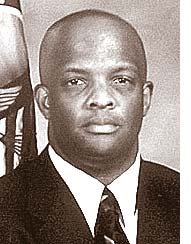A mixed first year for Yellow Springs Police chief
- Published: November 28, 2013
With just about a year under his belt as Yellow Springs police chief, Anthony Pettiford has made some strides and suffered a few setbacks. And with the decision of who to name as the first two sergeants the department has had in several years now on the front burner, Pettiford is about to set in motion his own tone for local law enforcement, which he articulated when he was hired.
“Community policing is a work in progress, especially with the new officers… but it’s important that people see you at all hours of the day so that you get to know villagers, and that residents get to know who you are,” he said in an interview last week. “We knew what the tone was and the direction we wanted to go.”
This year’s accomplishments include hiring two new officers with plans to hire an additional officer in the coming months. The move will bring the department’s total police officer count from seven to 10 (including the chief), moving it closer to Pettiford’s original goal to assign at least two officers to every shift for full, round-the-clock police coverage in the village.
“That’s always been important to me for safety purposes,” he said.

Yellow Springs Police Chief Anthony Pettiford is nearing the completion of his first year in office. (News file photo)
Chief Pettiford’s first year has also been a challenge. He was injured on the job in February and spent about eight weeks out of the office nursing an injured shoulder. Then in late July came the shooting incident involving 80 officers from other departments and the death of local resident Paul Schenck. And the following month, Village Manager Laura Curliss, who hired Pettiford last November, vacated her position with the Village.
And yet the difficulties of this year have not been confined to outside incidents. According to some inside the Village employ and others in the community who wished to remain unnamed, leadership within the department has not gone as hoped. Some regret that communications and directives from the chief have not been robust and have not come often enough to keep the department operating smoothly. Some are also concerned that authority within the department has been misapplied. And some community members feel that officers are sometimes being unnecessarily aggressive and that there is a lack of leadership to demonstrate what community policing is really about — especially since the chief no longer lives in the village.
In response to these concerns, Chief Pettiford said he is doing his best in a new position.
“All I can say is I’ve tried to do the best job that I can here,” he said. “Life happens, and life happened and I choose not to put my life out there.”
According to Village Interim Manager Kent Bristol this week, the chief recently asked him for some help dealing with the factionalization within the small department. He and Pettiford are currently “working on some projects together,” Bristol said, adding, “I’m convinced that we can improve the situation.”
Reached at home last week, Curliss said that Pettiford had been an excellent police chief and that the Village of Yellow Springs was “lucky to have him.”
Visibility and communication
When Pettiford applied for the chief position he repeatedly said that he was living in town and that he would have a visible presence in the village. When asked earlier this month, Pettiford said he lives outside the village and declined to specify where or when he left, saying he didn’t want to talk about his personal life.
But according to several villagers who did not wish to be named, having a chief who lives in town was a big reason they favored Pettiford. They wanted a chief who was close by, easily accessible and visibly engaged in the goings on of the community. When one villager who intitially supported the chief learned he had moved, she felt “deceived,” she said, asking to not be named in order to maintain civility with the community.
But “visibility does not equate accessibility” according to local business owner Bob Swaney. “Anyone who expects the streets to be the chief’s office is wrong.” He feels confident that the chief and his department are available and responsive when they are needed.
Mills Lawn Principal Matt Housh has also found Pettiford and the police department to be extremely supportive of the school’s youth safety patrol program, maintaining a presence every morning in front of the school and providing safety training and mentorship for the students.
But those with concerns about the chief’s accessibility aren’t confined to the public. A group of Village employees who wished to remain anonymous due to concerns about their jobs also said that they felt discouraged about a lack of approachability and leadership from their chief. The department staff has met about once per quarter, which is not enough to share information and keep everyone on the same page, many said (though Pettiford said that since September the meetings have been more frequent). Written directives about the schedule of events and the protocols for how to respond to particular inquiries and incidents with the public have also been sparse.
The lack of communication between the chief and the staff, several employees said, affects everything from departmental policy to culture and morale, which for some is very low. Encouragement and positive feedback have also been lacking, which caps the general disunity and lack of “team” spirit among the local police, they said. The door between the chief’s office and the department is always closed now, several said, which is tantamount to a “do not disturb” sign to the officers and dispatchers.
“We suffer when we don’t get information, and that breeds suspicion and rumors,” one employee said.
According to Bristol, the Yellow Springs police department has always tended to factionalize between those who favor strict law enforcement and those who prefer a problem solving, community-oriented policing style. According to Bristol, who was Village manager in the 1980s, formerly those who couldn’t adopt the less aggressive tone left for jobs outside the village. And when they couldn’t leave on their own, Bristol didn’t have a problem encouraging them, including Police Chief Wylie Sampson, who was let go because his style wasn’t “a good fit” with the village.
But what Bristol sees now is Pettiford carrying on the same approach that former Chief John Grote took as a “middle of the road” tack to issues. He cited drug use as one example. The department won’t necessarily go looking for it, but if officers find citizens using drugs in the village, they will issue citations.
“It’s not a crusade, but when drugs fall into your lap, you’re not going to ignore it either,” he said. “I would never endorse deliberately taking it easy on drug enforcement.”
Villagers question local policing
None of the village residents who spoke to the News anonymously about their experiences with police spoke about drug use, but several in the past year have encountered officers both new and experienced who seemed to be unnecessarily suspicious and aggressive. During such incidents — one was a traffic stop, one occurred while a villager was walking in the village at night, and another was an encounter with police during the day on public property — villagers said police were “condescending,” “intimidating,” and “harrassing.” Villagers asked that the incidents not be described in detail because they said they felt distrustful of police and concerned for their safety.
One resident, Kate Hamilton, feels that perhaps the shooting standoff in July exacerbated the negative perceptions between police and the citizens, creating an “us versus them” mentality on both sides. And she feels concerned that no one within the police department is addressing the issues the public has voiced. Several people who spoke off the record said that they had formally complained to the chief, and one said that the outcome was never made clear. Hamilton wondered whether the officers were acting according to departmental policy, and if not, who is training them to act in a more appropriate manner? Hamilton asked. Trust between some local residents and the chief, in other words, is wearing thin.
“I wish there was a way to have the lines of communication more open,” Hamilton said. “We need to heal together … or we’re going to lose the good officers because of a negative work environment and there being no agreement on how to handle community incidents.”
According to Pettiford, the department has received no official complaints from citizens about aggressive officers. If he did, he “would take care of it and talk to the officer about it, taking corrective action if needed,” he said. What he has heard are rumors through Facebook that may be creating a false “perception” about police. Those kinds of issues are “hard to follow up on because there’s no direct contact” with the complainant, he said.
Regarding his accessibility, Pettiford said he has always made himself available to meet with the public and that though “a lot of things keep me in the office,” villagers should not hesitate to contact him.
High quality law enforcement
According to the Village code, the police department should include as officers a chief, a captain and two sergeants. Yet in the recent past, Village police have operated under the stress of both a lack of personnel as well as having neither sergeants nor captains. Since his arrival, Pettiford has taken up the charge that Interim Chief Arthur Scott started last year to reverse that trend by increasing officer training, adding personnel to the ranks and agreeing to create additional leadership positions on the squad.
“I had to build some things first, starting with getting supervisors in place,” he said.
The process for selecting sergeants began in late summer. Five officers applied, but two have since dropped out of the running, leaving three applicants for two positions. Pettiford and Curliss decided to use a review panel of three police captains from surrounding agencies to interview each candidate, focusing especially on leadership skills and knowledge of supervision. The review panel made recommendations to the chief and the Village manager, who will conduct more interviews with the candidates to decide which are the best fit.
“What I’m looking for are supervisors that can be my right and my left hand,” Pettiford said. “Leaders who can run the department when I’m not here, make sure the shifts are following policies and procedures and help make key decisions.”
The decision will be up to both Pettiford and Bristol, and Pettiford said he hoped to name the sergeants sometime in the next few weeks.
Leadership questions
Still, some Village employees have concerns that the department won’t choose the most qualified candidates for the positions. Often in the past, in the absence of upper level officers, the department has relied on seniority to define the chain of command below the chief. But when Chief Pettiford was out due to injury beginning in February, he and Curliss named as acting chief the second most senior officer who had for several years been the department’s representative to the Greene County ACE Task Force in Xenia. Several employees questioned the wisdom of that decision, given the acting chief’s limited experience and training in staff supervision, as well as a recent lack of experience on road duty in the village. The move was further questioned after the handling of a police incident that occurred in the spring under the acting chief.
On April 4 an employee from the downtown business Jennifer’s Touch called police to report a robbery. According to the clerk, a woman in a coat and sunglasses had just entered the store, threatened the clerk verbally and walked out with a case of metal rings, escaping in a vehicle waiting for her on the street outside. The dispatcher radioed for the only officer on duty to respond, but he was busy on a warrant service. The officer arrived about 15 minutes after the initial call and took statements, including the suspects’ license plate number, to begin an investigation.
According to Village employees, Chief Pettiford had sent a department-wide memo in early spring telling all personnel to immediately inform the chief officer of any serious incidents that could endanger the public or an officer. In the case of the robbery, according to a memo from the acting chief, the dispatcher did not inform the acting chief, who later reported to Pettiford that the dispatcher was guilty of dereliction of duty and insubordination (for asking the acting chief why authority had not been given to the most senior officer.)
There is no record of the disciplinary action that was taken against the dispatcher, but three weeks later, after seven years as a Village employee, the dispatcher resigned her position with the Village. She had no other negative evaluation in her personnel file.
Several Village employees classified a “robbery” as a “routine” incident (different from a burglary, in which the offender forces entry) that occurs almost weekly in the village and is not the kind of call a dispatcher would necessarily inform the chief about right away. Furthermore, several said, the dispatcher was a reliable employee and that if she had to be disciplined, a verbal reprimand or even a written reprimand should have sufficed. And since the incident was questionable, the chief should have completed an internal investigation to determine if the facts were correct. According to those involved, the chief never investigated the report.
When asked about the April incident and any disciplinary action against the dispatcher, Pettiford said he did not recall the event and could not comment. According to Bristol, if the dispatcher felt unfairly treated, the Village has an appeals process that she could have engaged in order to dispute her treatment.
And regarding his leadership decisions, he and Curliss made the decisions together, Pettiford said, stating that he has always chosen to distribute authority among several of the senior officers.
A year in review
Asked recently what he is most proud of accomplishing this year, Pettiford referred to his staff.
“The men and women of this department and the people who do this job on a day-to-day basis — I’m proud to be a part of that,” he said. “I have a good crew here, and I hope I can lead them to make this department one of the best departments in this area.”
The chief’s position is traditionally an at-will employee of the Village who starts with a one-year probationary period. According to Bristol, Pettiford’s probation ends this week, but it could conceivably be extended, given the fact that Bristol, who oversees the chief, is neither the permanent manager nor the one most familiar with the chief’s first year on the job. He said that he intended to leave an appraisal of the situation for the next manager to review.
In the meantime, Bristol and the chief will be working together to address the strife currently brewing within the department. Pettiford came to him to ask for help, and so far, Bristol said, “we’re making some progress.”














No comments yet for this article.